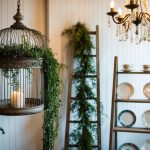The Best Home Decor Trends That Will Never Go Out of Style: Timeless Design Ideas
Wainscoting and Paneling
Wainscoting and paneling have historical roots dating back to the 16th century and remain enduring features in home decor. These elements provide both aesthetic and practical benefits, adding texture and interest to walls while offering protection against scuffs and damage. Wainscoting typically involves wood paneling installed on the lower part of the walls, usually topped with a chair rail. Various styles, such as beadboard, raised panels, and flat panels, offer different visual effects. Paneling can extend to full walls, featuring vertical or horizontal planks that suit diverse design preferences. Materials commonly used include wood, MDF, and even synthetic options, each offering its unique look and benefits. Wood can be stained to reveal its natural grain or painted for a clean finish, while MDF offers a more budget-friendly choice with smooth surfaces that are easy to paint. By incorporating wainscoting and paneling, homeowners can add architectural interest, warmth, and elegance to any interior space.
Iconic Design Styles
Certain design styles remain timeless, combining aesthetics with functionality. These styles offer unique characteristics that keep them perennial favorites.
Mid-Century Modern
Mid-Century Modern design is characterized by clean lines, organic curves, and a functional approach to furniture. Its origins can be traced back to post-World War II, an era that emphasized simplicity and connection with nature.
Furniture in this style often utilizes materials like teak, walnut, and oak. Unique pieces like the Eames Lounge Chair represent the pinnacle of Mid-Century Modern design.
Colors range from rich earth tones to vibrant primary colors. Key elements include open spaces, large windows, and minimalistic decor. These features help create a sense of spaciousness and calm, making it a popular choice for contemporary homes.
Scandinavian Simplicity
Scandinavian design focuses on minimalism, functionality, and a connection with nature. Originating from the Nordic countries, this style emphasizes light, airy spaces with neutral colors. It often includes elements made from natural materials like wood, wool, and leather.
Key features include clean lines, simple forms, and a lack of clutter. Furniture pieces often have a dual purpose, combining form and function seamlessly. The design also incorporates cozy elements like soft textiles, adding warmth to the minimalist settings.
Lighting is crucial, with an emphasis on maximizing natural light through large windows. Artificial lighting is typically soft and warm, enhancing the cozy atmosphere.
Traditional Comfort
Traditional comfort style draws inspiration from classic European decor. This design emphasizes rich fabrics, ornate furniture, and detailed craftsmanship. It often features elements like patterned wallpaper, elegant draperies, and antique furniture pieces.
Color palettes typically include deep, rich tones such as burgundy, gold, and forest green. Furniture is often crafted from dark woods like mahogany or cherry, and upholstery might feature intricate patterns or embroidery.
Accents may include decorative artworks, elegant mirrors, and intricate rugs. This style creates a warm, inviting atmosphere that evokes a sense of timeless elegance and sophistication.
Seasonal Adaptability
Adapting home decor to different seasons can be seamlessly achieved through changeable accessories, adaptable color palettes, and themed decor switch-outs, ensuring the space feels fresh and relevant all year round.
Changeable Accessories
Accessories like throw pillows, curtains, and rugs can be easily swapped to reflect seasonal changes. In the fall, warm-toned pillows and heavier curtains provide coziness. For spring, light and airy fabrics can create a fresh look. Simple adjustments like these can significantly change the feel of a room without requiring a complete redesign. Decorative items like vases, candles, and artwork can also be rotated to match the season, providing an easy and effective way to refresh the space.
Adaptable Color Palettes
Choosing a foundational color palette that works year-round makes seasonal adaptation straightforward. Neutral tones like beige, white, and gray can serve as a base, allowing for the addition of seasonal accent colors. For instance, vibrant yellows and greens can be introduced in the summer, while rich reds and golds can warm up the space during winter. By maintaining a versatile base, it becomes simple to make adjustments that align with different times of the year. This approach ensures continuity and coherence in decor while allowing for seasonal updates.
Themed Decor Switch-outs
Incorporating themed decor for different holidays or seasons can add a festive touch to any home. During winter, items like wreaths, garlands, and holiday-specific decor can create a cozy and celebratory atmosphere. Spring might see the introduction of floral arrangements and pastel-colored items. These themed switch-outs do not need to be extensive; even small touches can make a significant impact. By keeping a curated collection of seasonal-themed decor, changing the look of a home to match the season becomes an easy and enjoyable task.



